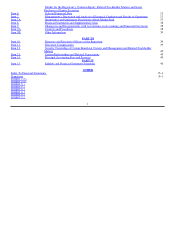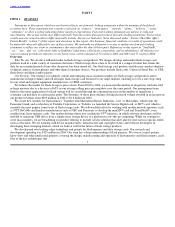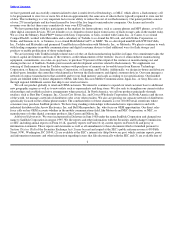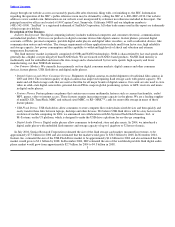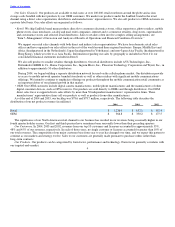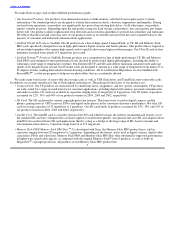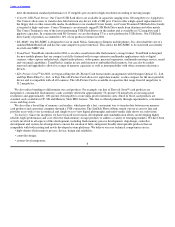SanDisk 2004 Annual Report Download - page 13
Download and view the complete annual report
Please find page 13 of the 2004 SanDisk annual report below. You can navigate through the pages in the report by either clicking on the pages listed below, or by using the keyword search tool below to find specific information within the annual report.
Table of Contents
depend on third−party foundries for silicon supply and any shortage or disruption in our supply from these sources will reduce
our revenues, earnings and gross margins.”
• Testing and Assembly. We sort and test our wafers at Toshiba in Yokkaichi, Japan, and United Test Center, Inc., in Taiwan. Our
tested wafers are then shipped to our third−party memory assembly subcontractors, including StatsChipPAC Ltd., or
StatsChipPAC, in China, and Silicon Precision Industries Co., Ltd., or SPIL, in Taiwan, and Sharp and Mitsui & Co., Ltd., both
in Japan. Our packaged memory final test, card assembly and card test is performed at SPIL, United Test Center, ASE Group
and DataFab Systems, Inc. in Taiwan, and StatsChipPAC and Flextronics International, Ltd., or Flextronics, in China. We
believe our use of subcontractors reduces the cost of our operations and gives us access to increased production capacity. See,
“Item 7−Factors That May Affect Future Results−We depend on third−party subcontractors and our business could be harmed if
our subcontractors do not perform as planned.”
Ventures With Toshiba
FlashVision. In May 2000, we invested in the FlashVision venture, which operated in Manassas, Virginia until May 2002. In April
2002, we and Toshiba agreed to consolidate the NAND wafer fabrication manufacturing operations in Fabs 1 and 2 of Toshiba’s
Yokkaichi Operations in Japan, through a venture named FlashVision, Ltd., or FlashVision.
• Semiconductor Manufacturing Equipment. Toshiba owns the wafer fabrication facilities, Yokkaichi Fabs 1 and 2, in which
FlashVision’s tools are installed. We have also installed, in Yokkaichi Fabs 1 and 2, tools which we own directly providing us
with approximately 10% additional capacity, on approximately the same terms as FlashVision.
• Capitalization and Related Matters. We own 49.9% of FlashVision and Toshiba owns 50.1% of FlashVision. FlashVision’s
funding takes the form of permanent capital (38 billion Japanese yen in total) and loans (funded one−half by each owner) from
Toshiba and us. At the end of 2004, our loans to FlashVision were 3.6 billion Japanese yen and we are committed to fund an
additional 7.0 billion Japanese yen in 2005. FlashVision’s stated life will terminate in December 2016, but may be terminated by
Toshiba or by us by notice given from May 16, 2008 to May 15, 2009. There are other termination events described in the master
agreement and the operating agreement, which are exhibits to this report. Those agreements should be read carefully in their
entirety for a comprehensive understanding of our rights and obligations.
• Lease Facility. FlashVision sold and leased back from Mizuho Leasing tools, which had an original book value of 37.9 billion
Japanese yen. FlashVision has been making lease payments and the remaining fixed lease payment obligation was 23.1 billion
Japanese yen at the end of 2004. Toshiba guaranteed FlashVision’s performance of its obligations under the lease facility and we
agreed to reimburse Toshiba for 49.9% of its claims and associated expenses related to its guarantee agreement, unless those
claims resulted from Toshiba’s failure to meet its obligations to FlashVision or breach of Toshiba’s covenants with the lessors.
We pay Toshiba a credit enhancement fee for providing the direct guarantee of FlashVision’s lease obligations. In May 2006,
FlashVision has the option of purchasing the tools from the lessors. FlashVision is obligated to insure the equipment, maintain
the equipment in accordance with the manufacturers’ recommendations and other customary terms to protect the leased assets.
The lease agreement contains customary events of default for a Japanese lease facility.
• Operations. FlashVision’s current production ramp plan contemplates a technology transition from 90−nanometers to
70−nanometers in 2005. FlashVision sells wafers to Toshiba and to us at manufacturing cost. FlashVision generates cash over
time as a result of being paid as part of manufacturing cost for its non−cash depreciation expense. This cash is currently expected
to be used to fund expansion of FlashVision’s flash memory manufacturing capacity and to repay loans from Toshiba and us. We
and Toshiba are each committed to take 50 percent of FlashVision’s wafer output, with each company specifying the type of
wafer in its allocation. 8




